Oldsmobile Cutlass Supreme 1995 Owner's Manuals
Manufacturer: OLDSMOBILE, Model Year: 1995, Model line: Cutlass Supreme, Model: Oldsmobile Cutlass Supreme 1995Pages: 340, PDF Size: 16.68 MB
Page 151 of 340
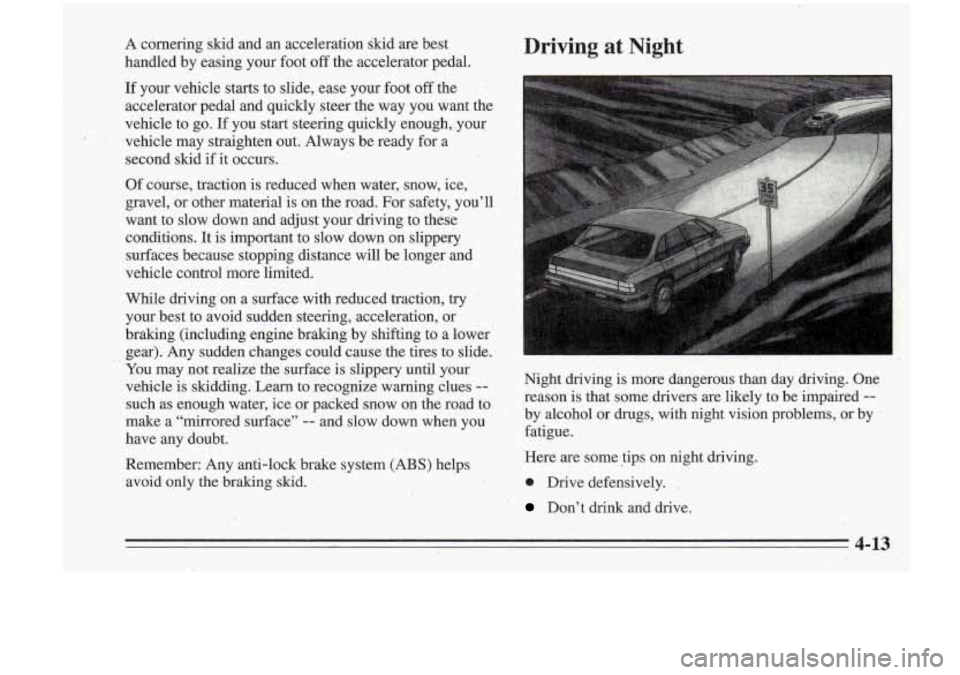
A cornering skid and an acceleration skid are best
handled by easing your foot
off the acce1,erator pedal.
If your. vehicle starts to slide, ease your foot off the ’’
accelerator pedal and’ quickly steer the way you want the
vehicle to go. If you start steering quickly enough,.your
vehicle may straighten out. Always be ready for a
second skid if
it occurs.
Of course, traction is reduced vvhen water, snow, ice,
gravel,
or other material is on the road. For safety, you’ll
want to slow down and adjust your driving to these
conditions. It is important to slow down on slippery
surfaces because stopping distance will ,be longer and
vehicle‘ control more limited.
While driving-on
a surface with reduced traction, try .
your best to avoid sudden steering, acceleration, or
braking (including engine braking by shifting to a lower
gear). Any sudden changes could cause the tires to slide.
You may
pot realize the surface is slippery until your
vehicle is skidding. Learn to recognize warning clues
--
such as enough water, ice or packed snow on the road to
make a “mirrored surface” -- and slow down when you
have any doubt.
Remember: Any anti-lock brake system
(ABS) helps
avoid,only the braking skid.
Driving at Night
I ~
Night driving is rnore’dangerous than day driying. One
reason is that some drivers are likely to be impaired-
--
by alcohol or drugs, with night vision problems, or by .
fatigue.
Here are some tips on night driving.
0 Drive defensively. -
’ Don’t drink and drive.
4-13 ,.
Page 152 of 340
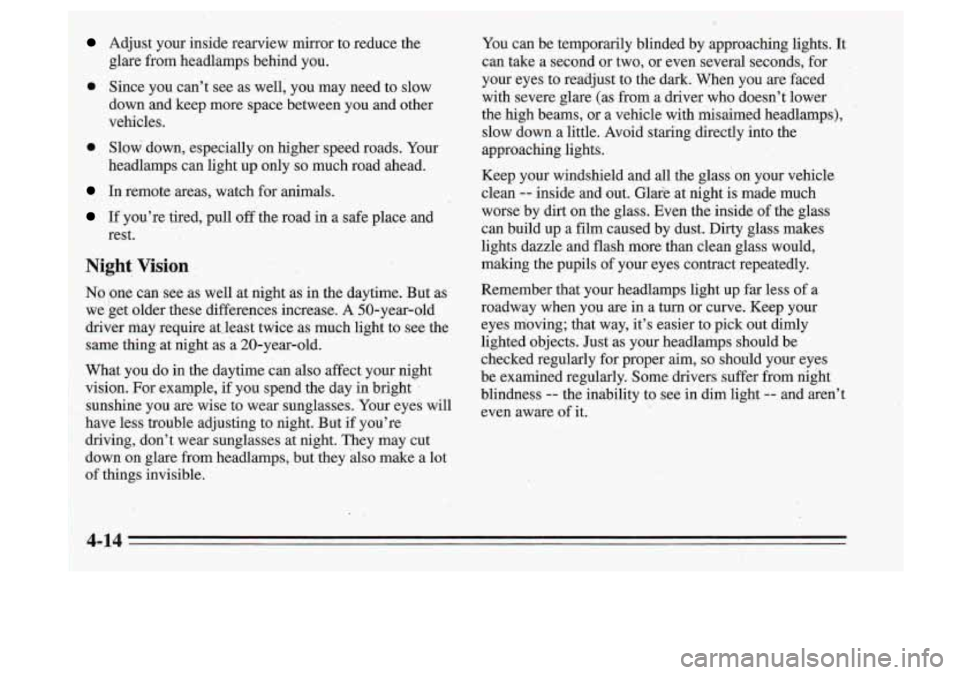
Adjust your inside rearview mirror to reduce the
. glare from headlamps behind you.
,e Since you can’t see as well, you may need to slow
down and keep more space between you .and other
. .. : vehicles.
Slow down, especially
on higher speed roads. Your
beadlpps can light up only
so much road ahead.
In remote areas, watch for animals.
If you’re tired, pull off the road in a safe place and
Night, Vision
No :one can see as well at night as in the daytime. But as
we get older these differences increase. A 50-year-old
driver may require at. least twice as much light to see the
same thing at night as a 20-year-old.
What you do
in the daytime can also affect your night
vision.
For example, if you spend the day in bright .
sunshine you are wise to wear sunglasses. Your eyes will
have less trouble adjusting to night.
Bat if you’re
driving, don’t wear sunglasses at night. They may cut
down on glare from headlamps, but they also make a lot
of things invisible. rest.
You
can be temporarily blinded by approaching lights. It
can take a second or two, or even several seconds, for
your eyes to readjust to the dark. When you are faced
with severe glare (as from a driver who doesn’t lower
the high beams, or a vehicle with misaimed headlamps), slow down a little. Avoid staring directly into the
approaching lights.
Keep your windshield and all
the glass on your vehicle
clean
-- inside and out. Glee at night is made much
worse by dirt on the glass. Even the inside of the glass
can build up a film caused by dust. Dirty glass makes
lights dazzle and flash more than clean glass would,
making the pupils
of your eyes contract repeatedly.
Remember that your headlamps light up far less of
a
roadway when you are in a turn or curve. Keep your
eyes moving; that way, ips easier to pick out dimly
lighted objects. Just as your headlamps should be checked regularly for proper aim,
SO should your eyes
be examined regularly. Some drivers suffer from night
blindness
3- the inability to see in dim light -- and aren’t
even aware of it.
4-14 .. .. .
Page 153 of 340
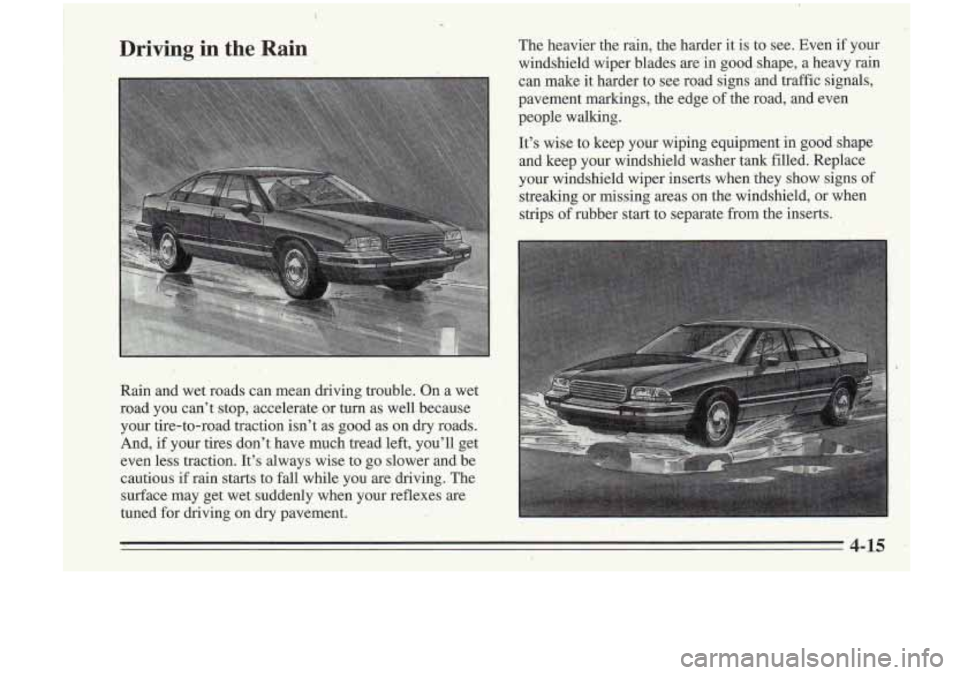
Driving in the Rain
Rain and wet roads can mean driving trouble. On a wet
road you can’t stop, aGcelerate or turn as well because
your tire-to-road traction isn’t as, good as on dry roads.
And, if your tires don’t have much tread left, you’ll get
even less traction.. It’s always wise to go slower and be
cautious
if rain starts to fall while you are driving. The
surface may get wet suddenly when your reflexes are
tuned for driving on.dry pavement. The
heavier the rain, the harder it is to see. Even if your
windshield wiper blades are in good shape, a heavy
rain
can make it harder to see road signs and traffic signals,
pavement markings, the edge of the road, and even
people walking.
It’s wise to keep your wiping equipment in good shape
and keep your windshield washer tank filled. Replace
your windshield wiper inserts when they show signs of
streaking or mising areas on the windshield, or when
strips of rubber start to separate from the inserts.
i
. 4-15
~~ I
Page 154 of 340
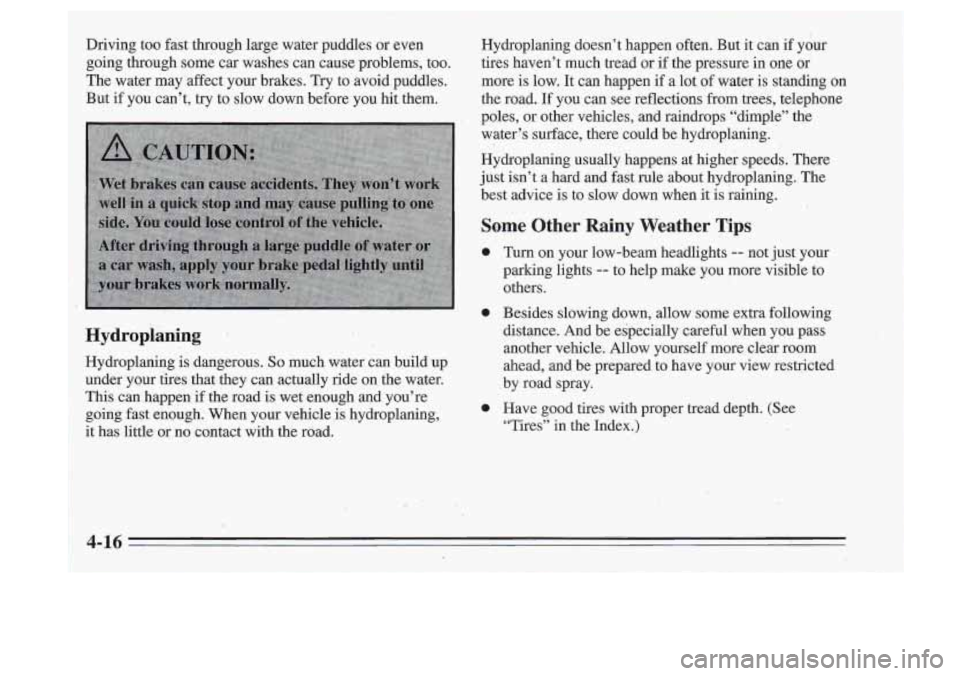
!
Driving too fast through large water puddles or even going through some car washes can cause problems, too.
The water may affect your brakes. Try to avoid puddles.
But if you can’t, try to slow down before you hit them.
Hydroplaning
Hydroplaning is dangerous. So much water can build up
under your tires that they can actually ride on the water.
This can happen if the road is wet enough and you’re
going fast enough. When your vehicle is hydroplaning,
it has little or no contact with the road. Hydroplaning doesn’t .happen often. But
it can if your
tires haven’t much tread or
if the pressure in one or
more
is low. It can happen if a lot, of water is standing on
the road. If you can see reflections froin trees, telephone
poles,
or other vehicles, and raindrops “dimple” the
water’s surface, there could be hydroplaning.
Hydroplaning usually happens at higher speeds. There
just isn’t a hard and fast
rule about hydroplaning. The
best advice
is to slow down when it is iaining.
Some Other Rainy weather Tips
1
0
0
0
,Turn on your low-beam headlights -- not just your
parking lights
-- to help make you ,more visible to
others.
Besides slowing down, allow some extra following distance. And be especially carefbl when you pass
another vehicle. Allow yourself more clear room
ahead, and, be prepared to have your view restricted
by road spray.
Have good tires with proper tread depth. (See “Tires” in the Index.)
Page 155 of 340
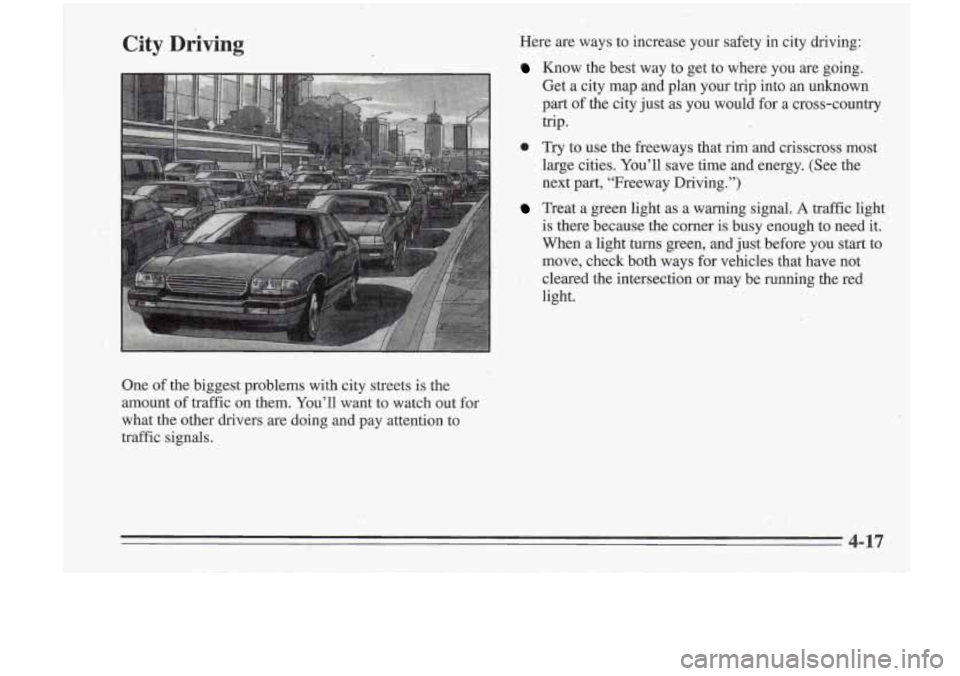
City Driving Here are ways to increase your safety in city driving:
Know the best way to get to where you are going.
Get a city map and plan your trip into an unkriown
part of the city just as you would for .a cross-country
trip.
0 Try to use the freeways that rim and crisscross most
large cities. You’ll save time and energy. (See the
next part, “Freeway Driving.”)
Treat a green light as a warning signal. A traffic light
is there because the corner is busy enough
to need it.
When a light
hulls green, and just before you start to
move, check both ways for vehicles that have not
cleared the intersection or may be running the red
light.
One
of the. biggest problems with city streets is the
amount of traffic on them. You’ll want to watch out for
what the other drivers are doing and pay attention to
traffic signals.
Page 156 of 340
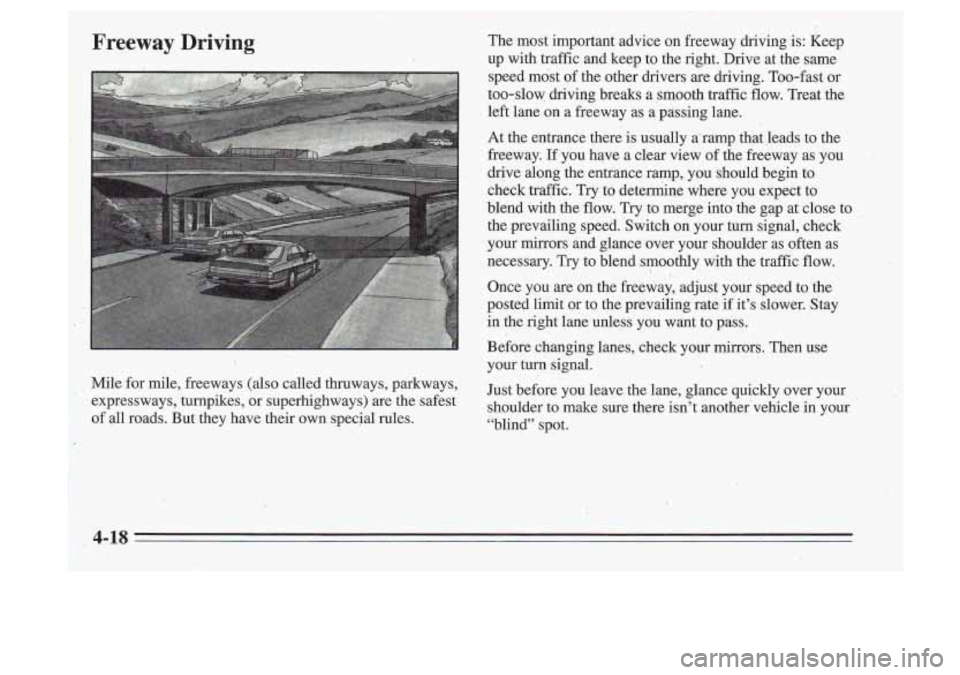
Page 157 of 340
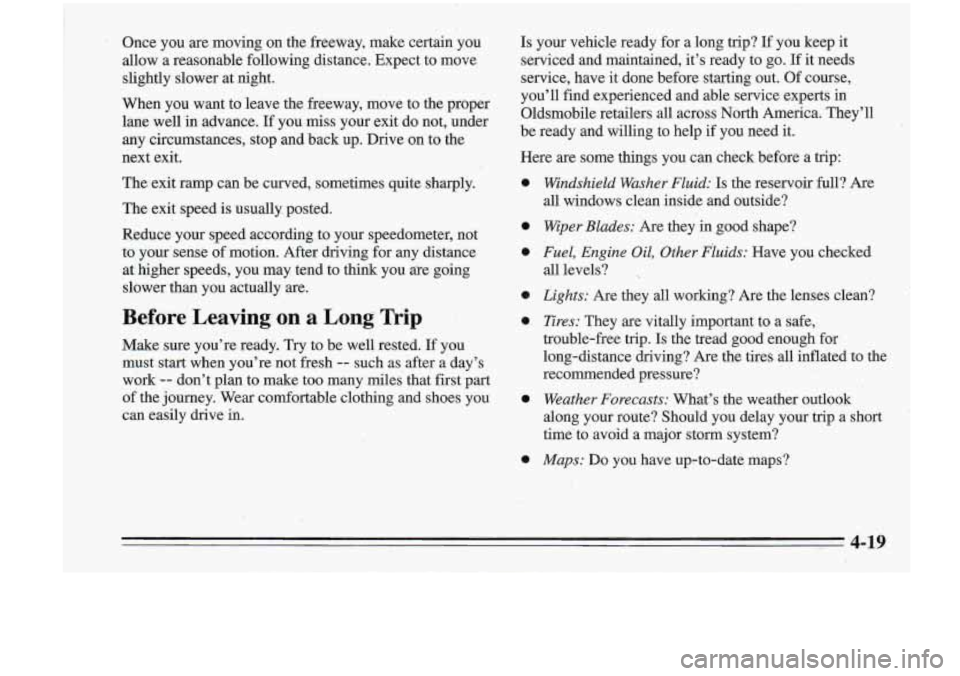
3 Once you are m,oving on the freeway, make certain you
allow a reasonable following distance. Expect to move
slightly slower at night.
When you want to leave the freeway, move to the proper
lane well in advance.
If you-miss your exit do not, under
any circumstances, stop and back up. Drive on to the
next exit.
The exit ramp can be curved, sometimes quite sharply.
The exit speed is usually. posted.
Reduce your speed according to your speedometer, not
to your sense of motion. After driving for any distance
at higher speeds, you may tend to think you are going
slower’than you actually are.
Before Leaving on a Long- Trip
Make sure you’re ready. Try to be well rested. If you
must
start when you’re not fresh -- such as after a day’s
work
.-- don’t plan to make too many miles that first part
of the journey. Wear comfortable clothing and shoes you
can easily drive in. Is your vehicle ready
for a long trip? If you keep it
serviced and maintained, it’s ready to go.
If it needs
service, have it done before starting out. Of course,
you’ll find experienced and able service experts in
Oldsmobile retailers all across North America. They’ll
be ready and willing to help
if you need it.
Here are some things you can check before a trip:
0
0
0
0
0
0
0
,Windshield Washer Fluid: Is the reservoir full? Are
all windows clean inside and outside?
Wiper Blades: Are they in good shape?
Fuel, Engine Oil, Other FZuids: Have you checked
all levels?
,
Lights: Are .they all working? Are the lenses clean?
Tires: They are vitally important to a safe,
trouble-free trip. Is the tread gaod enough for
long-distance driving? Are the tires all inflated to the
recommended pressure?
Weather Forecasts: What’s the weather outlook
along your route? Should you delay your trip a short
time‘to avoid a major
storm system?
Maps: Do you have up-to-date maps?
,
Page 158 of 340

Page 159 of 340
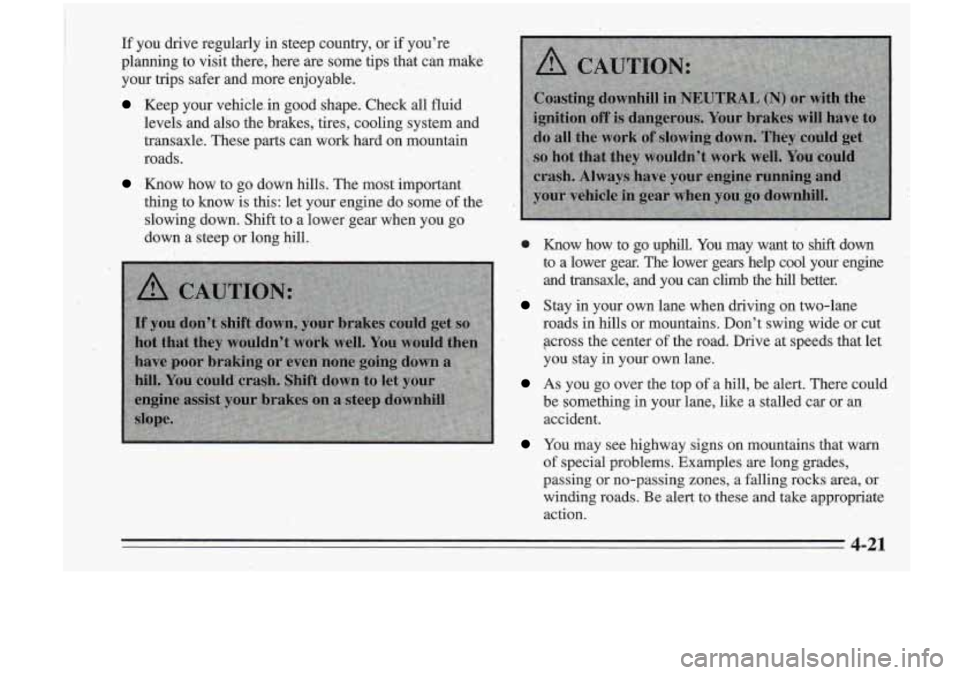
If you drive regularly in steep country, or if you're
planning to visit there, here are some tips that can make
your trips safer and more enjoyable.
Keep your vehicle-in good shape. Check all fluid
1evel.s and. also the brakes; tires, cooling system and
..
transaxle. These parts can work,hard on mountain
roads.
Know how to go down hills. The most important
thing to know is this: let your' engine do some of the
slowing down. Shift to a lower, gear when you go
down a steep or long hill.
e Know, how to gauphill. You may want to shift down
to a lower gek The 1ower.gearshelp cool your engine
and tramaxle, and you can climb the hill better.,
Stay in your own lane when driving on two-lane
roads
iri hills or mountains. Don't swing wide or cut
'% across the center of the road, Drive at speeds that let
you stay
in your own lane.
As you go over the top of a hill, be alert. There, dould
be something in your lane, like a stalled ca~
or an
accident.
You.m&y see highway ,signs on mountains that warn
,of special problems. Examples are long grades,
passing
or no-passing zones, a falling rocks &ea, or
winding roads. Be aleq to these aad'take appropriate
action.
,,
4-21
Page 160 of 340
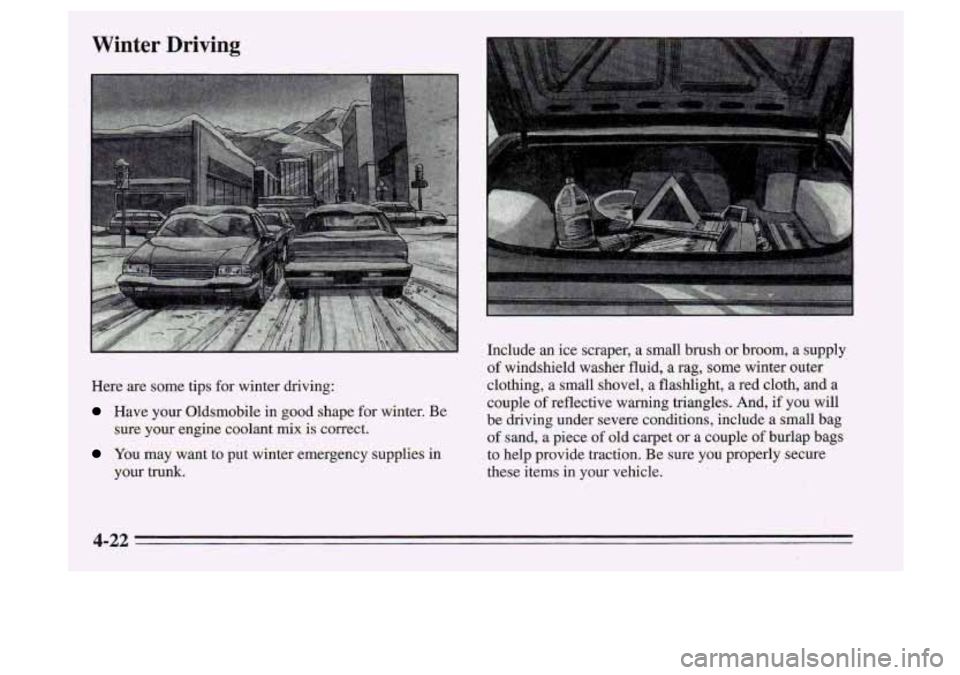
Winter Driving
Here are some tips for winter driving:
Have your Oldsmobile in good shape for winter. Be
You may want to put winter emergency supplies in
sure your
engine coolant
mix is correct.
your
trunk.
Include an ice scraper, a small brush or broom, a supply
of .windshield washer fluid, a rag, some winter outer
clothing, a small shovel,
.a flashlight, a red cloth, and a
couple of reflective warning triangles. And, if you will
be driving under severe conditidns, include a small bag
of sand, a piece of old carpet or a couple of burlap bags
to help provide .traction. Be sure you properly secure
these items in your vehicle.
4-22